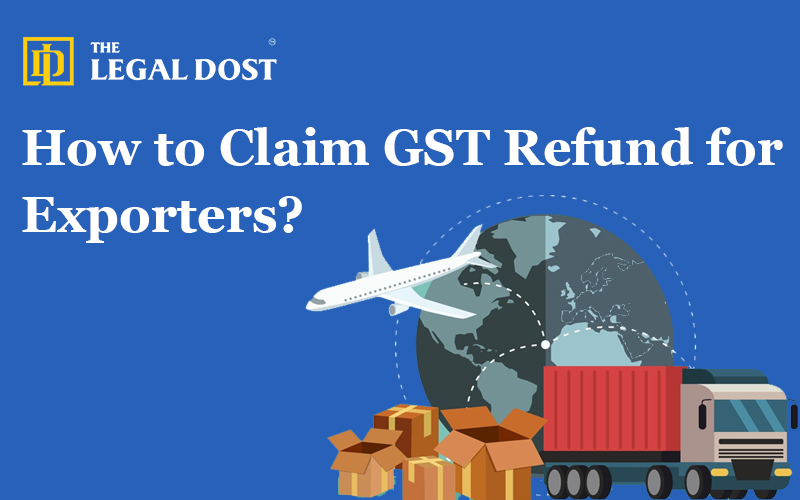Goods and Services Tax (GST) has streamlined India’s taxation system, benefiting businesses, including exporters. Exporters can avail of GST refunds, helping them remain competitive in the global market. In the export market, it is essential to understand for businesses engagement. In this blog we explain the Export GST refund procedure, IGST refund claims, and eligibility criteria to help exporters understand.
Understanding GST Refund for Exporters
Exporters can claim a GST refund under two scenarios:
Export with Payment of IGST: Exporters pay Integrated GST (IGST) on exports and later claim a refund.
Export under LUT/Bond (Zero-Rated Supply): No IGST is paid, and a refund is claimed for the Input Tax Credit (ITC) used in exports.
An export supply under the GST law is also called Zero-rated supplies, allowing businesses to claim a GST refund for export of goods and services without adding a tax burden. The rate of tax on export supplies is intended to effectively be nil or Zero.
GST Refund Eligibility for Exporters
To claim a tax refund for exports, an exporter must meet the following conditions:
- To qualify the supplier needs to provide an export of goods or services.
- A correct filing of GST returns by the exporter is required.
- A refund opportunity exists for GST payments on goods or services exported from the territory. Exporters must meet the deadline requirement to submit every necessary export refund documentation.
- This deadline spans two years from the relevant date.
Steps to Apply for IGST Refund on Exports
Filing the GST Refund Application
The refund claim must be submitted using Form GST RFD-01 on the GST portal. The process differs based on the type of export:
- Exports with IGST payment: The system processes automatic refunds when exporters provide their export invoice GST data through GSTR-1 and GSTR-3B.
- Exports under LUT/Bond: Exporters need to submit their unutilized input tax credit refund claims by using the GST RFD-01 application.
Submitting Supporting Documents
The following documents required for GST refund in exports must be uploaded:
- Export invoices with GST details.
- Bill of Lading or Airway Bill. A business must submit an Export General Manifest (EGM) when reporting to customs.
- Bank realization certificate (BRC) or Foreign Inward Remittance Certificate (FIRC) for service exports.
- LUT/Bond (if applicable).
Verification by GST Authorities
Verification occurs after a refund application gets submitted when GST officers conduct checks against the export invoice GST records with Shipping Bills and EGMs. The verification process will result in rejection for any discovered inconsistencies.
Refund Approval and Disbursement
Bank account of the exporter receives the refund after successful verification is completed. Payment verification usually takes 60 days for completion though it may be expedited if all supporting documentation is present.
Common Reasons for GST Refund Rejection
Exporters must comply with requirements to avoid rejection. Common reasons include:
- A mismatch regarding document information occurs in GST tax filing reports.
- Incorrect or incomplete documentation.
- Non-filing or delayed filing of GST returns.
- The failure to present export documentation within the set time limits leads to penalties.
GST Refund Rules for Export-Oriented Businesses
- Exports are treated as zero-rated supply under GST for exporters, meaning GST is not levied but is eligible for a refund.
- Refund claims must be filed within two years of the relevant date.
- ITC refunds apply only to inputs used in exporting goods and services.
- Compliance with GST return filing is mandatory for claiming refunds.
Latest Updates on GST Refund for Exporters
Recent updates in GST laws have streamlined the GST refund process for export businesses, ensuring faster processing and minimal manual intervention. Exporters must stay updated with GST compliance for exporters to benefit from refunds efficiently.
Conclusion
Exporters must follow the proper procedure to gain their GST refund as this process enables continuity in their cash flow and international trade competitive advantage. Exporters can claim their IGST refund easily with proper procedure observation and accurate documentation and GST regulation compliance to boost business operations.
The Legal Dost makes GST refund procedures simpler while assisting businesses to handle all GST compliance standards effortlessly. Our expert support system helps get you timely refunds which eliminates business financial challenges and sustains smooth business operations. You can start the procedure of claiming your GST refund effortlessly through The Legal Dost.
How to Claim GST Refund for Exporters? (FAQ’S)
Exporters who supply goods or services outside India can claim a GST refund, provided they file accurate GST returns and submit necessary export-related documents.
Exporters can claim a refund in two ways:
- With Payment of IGST: Exporters pay IGST on exports and claim a refund later.
- Under LUT/Bond (Zero-Rated Supply): No IGST is paid, and a refund is claimed for the Input Tax Credit (ITC) used in exports.
The GST refund is generally processed within 60 days after successful verification of documents by GST authorities. However, delays may occur if documentation is incomplete or incorrect.
Key documents include:
- Export invoices with GST details
- Bill of Lading or Airway Bill
- Export General Manifest (EGM)
- Bank Realization Certificate (BRC) or Foreign Inward Remittance Certificate (FIRC)
- LUT/Bond (if applicable)
No, GST refund claims must be filed within two years from the relevant date. Missing the deadline results in losing the refund eligibility.
Common reasons for rejection include:
- Mismatches in GST filing reports
- Incomplete or incorrect documentation
- Delayed GST return filing
- Failure to submit required export documents within the stipulated time
The Legal Dost simplifies the GST refund process by assisting businesses in accurate documentation, ensuring compliance with GST regulations, and expediting refund claims to maintain cash flow efficiency.


